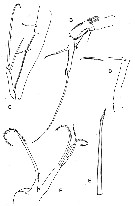|
|
 |
|
Siphonostomatoida ( Ordre ) |
|
|
| |
| | | |
| Megapontiidae Heptner, 1968 ( Siphonostomatoida ) | | Ref.: | Heptner, 1968 a (p.1637); Kabata, 1979 (p.52); Razouls, 1982 (p.722); Bowman & Abele, 1982 (p.12); Huys & Boxshall, 1991 (p.243, 250, 422, 464 ); Razouls, 1993 (p.313); Boxshall & Halsey, 2004 (p.16; 785: Def.); Vives & Shmeleva, 2010 (p.400, Rem., spp. key.) | | Rem.: | Formes commensales, accidentellement dans le plancton. 1 G.: Hyalopontius. |  Issued from : G.A. Boxshall & S.H. Halsey in An Introduction to Copepod Diversity, Part II, The Ray Society, 2004, Part II, No 166. [p.785]. Spine (Roman numerals) and setae (Arabic numerals) formula of swimmings legs P1 to P4. Element (s) on the outer margin of any segment are given first, separatd by a hyphen from the inner margin element (s) Nota: Swimming legs P1 to P4 biramous with 3-segmented rami. Intercoxal sclerites present. Inner seta on basis of P1 absent. - P5 with protopodal segment fused ton somite; exopod 1-segmented with 3 setae; endopod absent. P6 represented by a single seta on genital operculum in female and by a lobe bearing 1 seta and 2 spines in male. |
 Issued from : G.A. Boxshall & S.H. Halsey in An Introduction to Copepod Diversity, Part II, The Ray Society, 2004, Part II, No 166. [p.786, Fig.266]. A, Hyalopontius enormis female; B, Hyalopontius typicus female A2; C, Mxp; D, Hyalopontius spinatus female Mx2; Md; F, Hyalopontius roei female Mx1. from Boxshall, 1979. | | | | | (1) Hyalopontius Sars, 1909 | |
| | Syn.: | Megapontius Hulsemann, 1965 (p.50) | | Ref.: | Sars, 1909 (p.6); Boxshall, 1979 (p.243, spp. Key); Razouls, 1982 (p.722); Boxshall, 1986 (p.160, 202); Huys & Boxshall,1991 (p.246, 326, 414); Vives & Shmeleva, 2010 (p.400, Rem., spp. key from Iberica Fauna.) | | Rem.: | Type: Hyalopontius typicus G.O. Sars,1909. Total: 9 spp. | | Remarques sur les dimensions et le sex-ratio: | | The mean female size is 5.170 mm (n = 9; SD = 1.0437) and the mean male size is 4,815 mm (n= 4; SD = 0.1895). The size ratio (Male: Female) for only one species is 0,949 or 94,9 %. |  Issued from : G.A. Boxshall & S.H. Halsey in An Introduction to Copepod Diversity, Part II, The Ray Society, 2004, No 166. [p.786, Fig.266, B-E]. Characteristics of cephalosome appendages: B, female A2 (from Hyalopontius typicus; C, Mxp; D, female Mx2 (from H. spinatus; E, Md; F, female Mx1 (from H. roei). | | | | | |
|
|
 Toute utilisation de ce site pour une publication sera mentionnée avec la référence suivante : Toute utilisation de ce site pour une publication sera mentionnée avec la référence suivante :
Razouls C., Desreumaux N., Kouwenberg J. et de Bovée F., 2005-2025. - Biodiversité des Copépodes planctoniques marins (morphologie, répartition géographique et données biologiques). Sorbonne Université, CNRS. Disponible sur http://copepodes.obs-banyuls.fr [Accédé le 21 octobre 2025] © copyright 2005-2025 Sorbonne Université, CNRS
|
|
 |
 |





